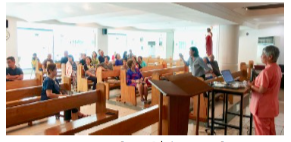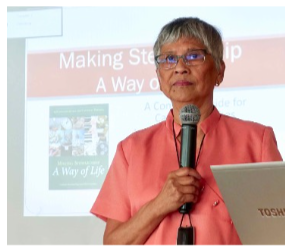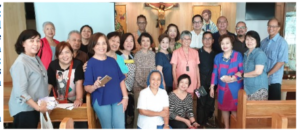Stewardship Author Narrates her U.S. Stewardship Experiences
Mila Glodava, a Fil-American and best- selling co-author of ‘Making Stewardship a Way of Life: A complete Guide for Catholic Parishes’, often referred to as the Philippine ‘bible’ for the journey to Stewardship, gave an enlightening talk to the Stewardship Committee and ‘friends’ last Saturday, May 18, at the Divine Mercy Chapel, from 10 am to 12 noon.
The book, a result of the successful pioneering journey of St. Thomas More (STM) parish in Englewood, Colorado, part of the Denver diocese, towards stewardship, was co-written by Fr. Matthew Kemberling, the parish priest who pushed for St. Thomas More to be a tithing or stewardship parish in 2000 when he took over as parish priest.
Mila informed the audience that in STM, they’ve divided their stewardship calendar into – Stewardship of Prayer, Stewardship of Time and Talent, Stewardship of Faith, Stewardship of Treasure, Stewardship of Vocations, and Stewardship of the Earth. Except for Stewardship of the Earth (celebrated on Earth Day), these are celebrated on a fourth quarter weekend.

The benefits of stewardship as a way of life include: the parish is a praying community centered around the Eucharist; Liturgies are well-planned, revenrent, and joyful; members and guests feel welcome; giving is cherished; celebrations are important (appreciation parties, feast days, anniversaries); evangelization and formation are the ultimate parish hallmarks; parishioners experience a personal conviction.
Mila gave focus on welcoming and hospitality. First, she insisted that welcoming is the responsibility of all parishioners. First timers must feel they belong and are appreciated. The parish on the other hand offers opportunities to become involved in parish life, maintains and equips its facilities especially its parking and its signages, and possesses a can do attitude.
Ms. Glodava claimed that by the time she and Fr. Matthew left in 2014, STM had given away nearly US$5M to charities – shelters, charity hospitals, children’s homes, Habitat for Humanity, etc. – at a rated of half a million dollars a year in the last five years. What was different was that at STM, they had only one month in the year when they talked about money, which is October. During three weekends, parishioners would make their annual offertory commitment and indicate these in specific tithing envelopes that served as a ‘contract’ with the parish. But in return, the treasure stewards expect transparency, with regular financial reports. The other revelation was that the parish did not collect at offertory during the weekday masses, to provide relief from donating on the weekend masses. She even postulated that if stewardship can take off everywhere in the country, the traditional arancel system of charging for sacraments still done by a few parishes can be fully abolished in all the parishes.
A natural fall-out from the authentic practice of stewardship as a way of life, argued Mila, was evangelization. When you get there, she said, the parish knows the faith, live the faith, and share the faith.


